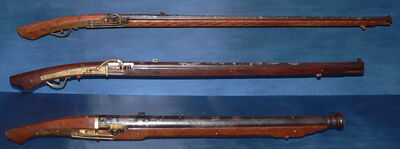
Arquebus muskets
The Arquebus is a matchlock firearm and forerunner of the modern rifle. It is the Long-Range weapon of Hernán Cortés
Description
The arquebus was a shoulder-fired firearm which used the matchlock mechanism, the first mechanism to facilitate the firing of a handheld firearm. The trigger on early arquebuses were similar to those of medieval crossbows. When the trigger was squeezed, a curved arm known as the serpentine was lowered, plunging a slow-burning match into the flashpan and firing the weapon. The show confirmed that it uses .69 to .80 caliber musketball rounds. The reloading time of an arquebus was about 30-60 seconds, depending on the model of the gun and the skill of the musketeer. The maximum effective range of an arquebus is about 100 meters with some sources claiming it could extend to 120 meters. This range dropped to 30 meters if the enemy was wearing plate armor; a shot from longer distance wouldn't be able to pierce a strong steel plate.
- Length: 44 inches
- Weight: 9 lbs
- Caliber: .69 to .80
- Muzzle Velocity: 1351 fps
Uses
The arquebus was widely used across Europe and in parts of Asia, beginning at the end of the Middle Ages. Because of the matchlock mechanism, the user could hold the weapon with both hands and keep his eyes on the target, offering a more accurate shot than earlier hand cannons, in which the user had to use one hand to ignite the powder or have someone else ignite it.
The arquebus was one of the first muskets used and help popularised the idea of guns and modern warfare. Despite it flaws, arquebuses were widly used as it required less money and training than bows and can pierce armor.
The arquebus was revolutionary for Japanese warfare, mainly during the Sengoku period. The intensity of war among the Japanese clans made most clans adopt the weapon, despite initially being avoided for being a 'dishonorable' weapon because of how easy it was to use. At the end of the Songoku period, Japan had their own gun factories and had more arquebuses than all of Europe.
The Mughal Empire introduced musket warfare in their conquests of India; where in the Battle of Haldighati, they used musket volleys to kill Rajput Warrior War Elephants.
Faults
Not all societies who witnessed the arquebus adopted it. Native Americans and other tribes of the world considered the weapon to be too slow firing, they had few resources to mass produce ammunition and they didn't need an armor piercing weapon since most of their enemies were lightly armored tribesmen. They preferred the bow for several centuries to the musket.
Because the match and powder was exposed, the arquebus was often unreliable in rain or high humidity. Future muskets would use wheellock or flintlock firing technology. Bows could still outperform the Arquebus in range and accuracy, and so archers still existed in certain armies. Some armies created special steel plate that was noticably thicker than before to be bulletproof, and was effective against guns until more powerful Muskets was invented.
Western warfare during the time of the arquebus still used traditional medieval melee weapons to support the slow rate of fire and poor accuracy of the arquebus. One of the most popular methods was the Pike and Shot, where spearmen would be a line of defense while the musketeers fired over them. As muskets improved this tactic was replaced by Napoleonic Warfare.